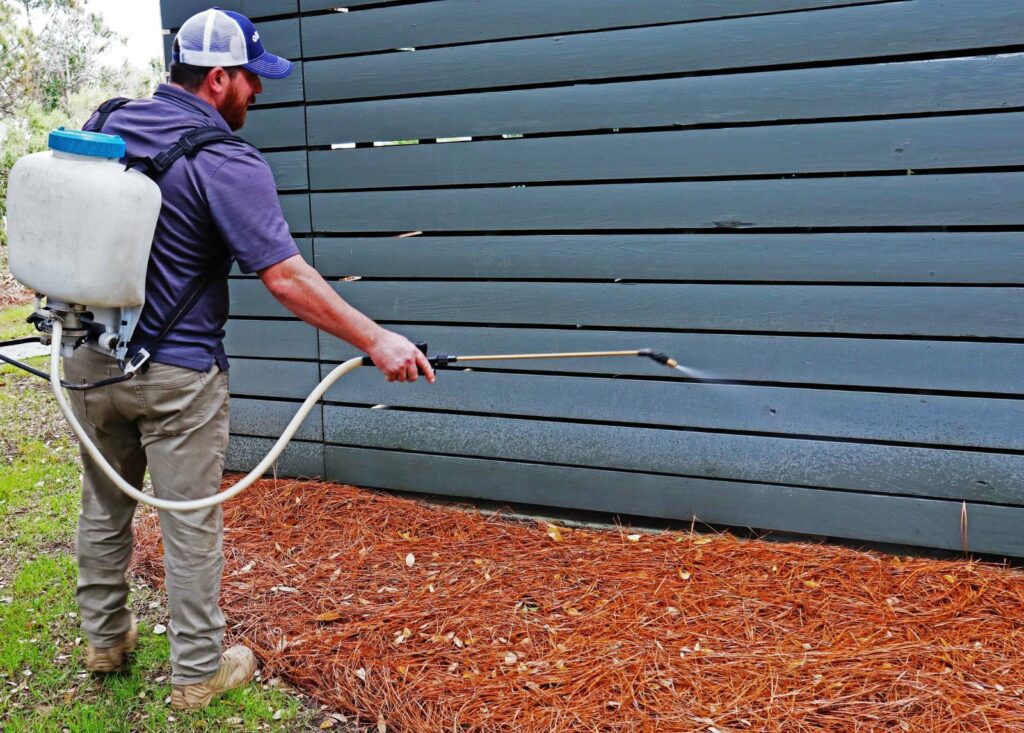
Contents
Just as a knight must armor up to battle a dragon, you need a solid plan for Flea Extermination to protect your pets from the relentless threat of fleas. These tiny parasites can wreak havoc on your furry friends’ health and comfort. Understanding the flea life cycle and recognizing the signs of an infestation are essential first steps. But how do you effectively combat this issue while ensuring your pets stay safe and happy?
Key Takeaways
- Hire professional extermination services for tailored flea solutions and effective treatments that prioritize pet safety.
- Regularly groom and vacuum your home to reduce flea habitats and minimize infestations.
- Wash pet bedding weekly in hot water to eliminate fleas, eggs, and larvae effectively.
- Use flea-repelling products like collars or topical treatments to provide ongoing protection for pets.
- Set up flea traps in high-traffic areas to monitor and capture adult fleas for better control.
Understanding Flea Life Cycle
Understanding the flea life cycle is essential for effectively combating these persistent pests, especially when your pets are involved.
Fleas reproduce rapidly, with females laying up to 50 eggs daily. These flea reproduction patterns contribute to swift infestations, making it vital for you to act quickly.
The flea life cycle consists of four developmental stages: egg, larva, pupa, and adult.
Once laid, eggs hatch into larvae within a week, feeding on organic debris.
After about 1 to 2 weeks, they spin cocoons and enter the pupa stage, where they can remain dormant for months.
When environmental conditions are right, they emerge as adults, ready to continue the cycle.
Signs of a Flea Infestation
Recognizing the signs of a flea infestation is key to protecting your pets and home. Start by observing your pets for excessive scratching, biting, or grooming. This behavior often indicates discomfort caused by fleas.
You might also notice tiny, dark specks—flea dirt—on their fur or bedding. Another sign is your pets’ restlessness, as they may struggle to settle due to irritation.
Infestation triggers can include warm, humid environments where fleas thrive. If you’ve brought in new pets or visited areas with known flea issues, keep a close eye on your fur babies.
Regularly inspect your home, especially carpets and upholstery, for signs of fleas or their eggs. By staying vigilant and recognizing these signs early, you’ll foster a safe and comfortable environment for your beloved companions.
Importance of Professional Extermination
When it comes to tackling a flea infestation, enlisting professional extermination services can make all the difference in reclaiming your home and ensuring your pets’ comfort. You might feel overwhelmed by the thought of handling it yourself, but with professional expertise, you’ll benefit from tailored solutions that address your specific situation.
Exterminators use effective strategies that not only eliminate fleas but also prevent future outbreaks, protecting your furry friends and your family. Moreover, professionals have access to products and techniques that are safe and effective, ensuring that your pets aren’t exposed to harmful substances.
This compassionate approach fosters a healthier environment for everyone in your household. By choosing to work with experts, you’re not just combating a nuisance; you’re investing in the well-being of your loved ones.
Choosing the Right Extermination Service
When choosing an extermination service for your pet’s flea problem, it’s essential to assess their experience and expertise in the field.
You should also compare their treatment methods to find one that suits your needs and preferences.
Finally, evaluating their safety practices will guarantee the well-being of your furry friend during the extermination process.
Assessing Service Experience
How can you guarantee that you choose the right extermination service for your pet’s flea problem? Start by researching the service’s reputation.
Look for companies with strong customer feedback; positive experiences from other pet owners can provide invaluable insight. Check online reviews and ask for recommendations from friends or local veterinarians.
A reliable extermination service should demonstrate compassion for your pets and a commitment to effective solutions. Additionally, inquire about their methods and safety measures to ascertain they’re suitable for your home environment.
Comparing Treatment Methods
Choosing the right extermination service for your pet’s flea problem requires a careful comparison of treatment methods.
You’ll find various options available, including chemical treatments and home remedies. Chemical treatments often provide quick results and are effective against stubborn infestations, but they may raise concerns about safety and environmental impact.
On the other hand, home remedies, such as diatomaceous earth or essential oils, can be gentler on your pet and the environment, although they might take longer to show results.
It’s crucial to take into account your pet’s health, your home environment, and your comfort level with each method. By weighing these factors, you can select a service that aligns with your values and guarantees your pet’s well-being.
Evaluating Safety Practices
While addressing a flea problem, it’s crucial to evaluate the safety practices of any extermination service you consider.
Start by asking about their flea toxicity assessment methods; you’ll want to verify they prioritize your pets’ health.
Look for services that adhere to stringent pet safety protocols, guaranteeing that any treatments used are safe for your furry family members.
Inquire about their experience with safe products, and don’t hesitate to request references from other pet owners.
A reputable service should be transparent about their processes and willing to answer your questions.
Choosing a service that values safety not only protects your pets but also gives you peace of mind during this challenging time.
Your pets deserve the best care possible.
Preventative Measures for Fleas
To keep fleas at bay, implementing preventative measures is essential for your pet’s health and comfort.
Start by adopting effective flea prevention strategies, like regular grooming and vacuuming your home. Keeping your living space clean reduces potential flea habitats. Consider using flea-repelling products on your pet, such as collars or topical treatments recommended by your vet.
In addition to these measures, home treatments can further protect your furry friend.
Wash your pet’s bedding weekly in hot water to eliminate any lurking fleas or eggs. You can also treat your yard with safe, pet-friendly insecticides, creating a barrier against fleas.
Safe Treatment Options for Pets
When it comes to treating fleas on your pets, you have several safe options to take into account.
Natural remedies can be effective, but veterinary-approved treatments often provide a reliable solution.
It’s important to choose methods that guarantee your pet’s health and comfort while effectively eliminating fleas.
Natural Remedies for Fleas
Natural remedies for fleas offer pet owners effective and safe treatment options that can help keep your furry friends comfortable and free from irritation.
These remedies harness the power of nature, making them a great choice for conscientious pet parents.
Consider these options:
- Essential Oils: Dilute oils like lavender or cedarwood and apply them to your pet’s collar for a natural deterrent.
- Herbal Remedies: Create a flea-repelling spray using vinegar and water or blend herbs like rosemary and mint to repel fleas.
- Diatomaceous Earth: Sprinkle food-grade diatomaceous earth in your pet’s bedding and around your home to dehydrate and eliminate fleas safely.
Veterinary-Approved Treatments
While natural remedies can be effective, sometimes it’s essential to rely on veterinary-approved treatments for flea control to guarantee your pet’s health and comfort.
Your veterinarian can recommend reliable flea medications that suit your pet’s specific needs, ensuring they’re safe and effective. Topical treatments are popular choices, as they offer quick relief and long-lasting protection.
These solutions often target adult fleas and their eggs, breaking the flea life cycle. It’s important to follow your vet’s guidance on application and dosage, as this helps maximize effectiveness while minimizing any potential side effects.
Maintaining a Flea-Free Environment
To keep your home flea-free, it’s vital to adopt a proactive approach that involves regular cleaning and monitoring.
Maintaining environment cleanliness not only benefits your pets but also creates a welcoming space for everyone in your home.
Here are three essential steps you can take:
- Regular Vacuuming: Vacuum carpets, upholstery, and pet bedding at least once a week. This helps remove flea eggs and larvae, reducing their chances of hatching.
- Use Flea Traps: Set up flea traps in strategic areas of your home. These traps can help monitor flea activity and capture adult fleas, providing insight into any potential infestations.
- Wash Pet Items: Regularly wash your pet’s bedding, toys, and blankets in hot water. This kills any lingering fleas and keeps your pets comfortable.
Wrap-Up
In your battle against fleas, think of your home as a fortress, and every preventive measure as a sturdy brick in its walls. By partnering with professionals and staying vigilant, you can create a safe haven for your pets, free from these relentless pests. Remember, a proactive approach—like regular grooming and thorough cleaning—acts as a shield, keeping your furry friends comfortable and happy. With dedication and care, you’ll guarantee their world remains flea-free and joyful.
Recent Posts
What Are Professional Flea Extermination Services?
If you’re dealing with a flea infestation, understanding professional flea extermination services is vital. These
Can You Really Keep Mice Out of Apartments?
Keeping mice out of apartments is more than just wishful thinking. By understanding their behavior
Stop Mice Infestations in Apartments Now
You might think Mice Infestations are a small nuisance, but they can escalate into a
